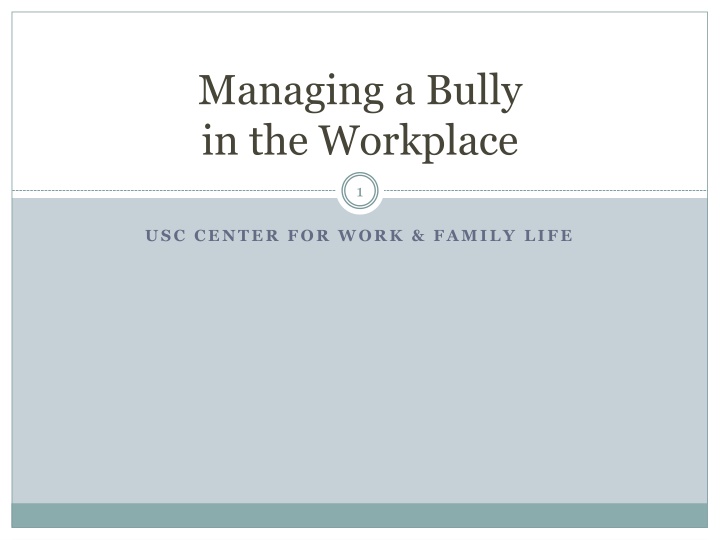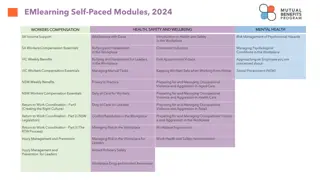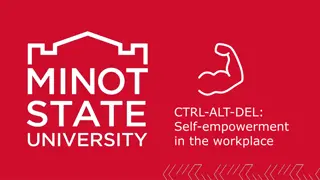Dealing with Workplace Bullies: A Comprehensive Guide
Workplace bullying is driven by power dynamics and can manifest through various behaviors such as sabotage, insults, and humiliation. Understanding the motivations and behaviors of bullies is crucial in recognizing and effectively managing their actions in the workplace. This guide delves into identifying signs of bullying, the psychology behind bullies, and common bullying behaviors to help individuals navigate challenging workplace situations.
Download Presentation

Please find below an Image/Link to download the presentation.
The content on the website is provided AS IS for your information and personal use only. It may not be sold, licensed, or shared on other websites without obtaining consent from the author.If you encounter any issues during the download, it is possible that the publisher has removed the file from their server.
You are allowed to download the files provided on this website for personal or commercial use, subject to the condition that they are used lawfully. All files are the property of their respective owners.
The content on the website is provided AS IS for your information and personal use only. It may not be sold, licensed, or shared on other websites without obtaining consent from the author.
E N D
Presentation Transcript
Managing a Bully in the Workplace 1 USC CENTER FOR WORK & FAMILY LIFE
Recognizing a Bully 2 Workplace bullying is about power and control in workplace relationships. It is often motivated by: insecurity jealousy or fear The intention of the perpetrator is the same to: undermine discredit embarrass, and/or harm the target Bullies control others through: sabotage insults undermining work performance public humiliation, and sarcasm
Recognizing a Bully 3 A bully is a person who is habitually cruel to others she deems to be weaker than herself and uses browbeating language and behavior. Although we often think of bullies as big people dominating smaller folks, they are truly little people in every way.
Recognizing a Bully 4 Their fear of being wrong is demonstrated by being know-it-alls. They are often condescending, patronizing or dismissive. Their fear of not being able to meet the needs of others causes them to never want to hear what others think, feel or want. Their inability and unwillingness to control their anger or their tongue causes them to make everything the fault of their coworkers, as it could not possibly be theirs. Paradoxically, their self-esteem is too fragile to handle the possibility of being wrong.
Recognizing a Bully 5 Their need to control their coworker demonstrates their fear of being unable to control themselves. Their desire for power over others comes from the fear of being insignificant. Their attempt to boost their own flailing self-esteem is fed by treating others disrespectfully, thoughtlessly and off-handedly. Their fear of others causes them to assault character, focus on weaknesses and be the poster children for intimidation. Unfortunately, these are all manifestations of a poor self- image coupled with lack of self-awareness and people skills.
Recognizing a Bully Top Ten Bullying Behaviors 6 1. Falsely accusing target of "errors" not actually made 2. Staring, glaring, nonverbally intimidating hostility 3. Publicly discounting target's thoughts or feelings 4. Giving target the "silent treatment & separating from others 5. Publicly exhibiting uncontrollable mood swings Source: Workplace Bullying Institute (WBI)
Recognizing a Bully Top Ten Bullying Behaviors 7 6. Creating own rules that even she/he did not follow 7. Disregarding satisfactory or exemplary work 8. Harshly & constantly criticizing target; different standard 9. Starting or perpetrating, destructive rumors/gossip about target 10. Encouraging people to turn against the person Source: Workplace Bullying Institute (WBI)
If You Are The Manager of a Bully 8 Step up, show up and speak up. Paradoxically, bullies want to be stopped. The bully cannot stop his or her own behavior because it is being driven by deep fear. Often, only a resounding wake-up call from management has any hope of bringing about change. Be proactive and act as soon as you see that bullying behaviors are frequent or habitual. If you have a bully on your team, be assertive. If you need to shore up your conflict and anger management skills, do so.
Managing A Bully 9 Begin with compassion. Beginning with an understanding of the inherent weakness the bully is projecting and its likely causes will help you manage. Bullies need to be managed because they cannot manage themselves No one wants to say no to them because of the consequences. That s the operating system of the bully: don t cross me or I will make your life miserable. Bullies appear self-confident, strong and impervious because they intimidate weaker people. If you vacillate, placate or submit to a bully or respond with fear or rage, she feels her point is proven: you are inferior and deserve to be abused, taken down or written off.
Tools for Managing the Bully 10 One major tool a bully uses is making threats. Management has more clout than bullies; therefore, they have a bigger threat: dismissal. Managers may fear that firing a bully will likely cause problems, even a lawsuit. It could happen, but that is something you have to be willing to risk if all other interventions fail. There are many other people in your team who are suffering from the bully s behavior. The sum of your team members count more than one bully!
Tools for Managing the Bully 11 Use the progressive discipline method to manage employee conduct Consult with your HR Partner for policies and procedures for progressive discipline Document, document, document If it wasn t written down, it didn t happen Keep a log of conversations you have had with the bully, and reports or observations of the bully s conduct Common steps in a progressive discipline model: Coaching Verbal warning Initial written warning Final written warning Termination 1) 2) 3) 4) 5)
Tools for Managing the Bully 12 Use the Performance Review process to document the problems and required improvements Becomes a part of the employee s personnel record As a part of the Performance Review development plan, offer meaningful and specific resources to assist the bully s success Sources of interpersonal training for the bully: Center for Work & Family Life Individualized treatment planning and interpersonal skill-building Services are free and confidential USC Professional Development Handling Emotions Under Pressure Career Track / Fred Pryor Seminars How to Communicate with Tact and Professionalism Developing Emotional Intelligence See Resources Page below for contact info
Tools for Managing the Bully 13 Seek the bully s commitment to change This problem is created by you alone, and only you can solve the problem. Will you make a commitment to me that you will make the necessary improvements? Don t let the bully distract you from securing their commitment, by blaming others, the university, or general circumstances. Increase 1:1 supervision meetings with the bully Lends more support to the bully to change his/her conduct Keeps the bully on your radar Sends a message that you are earnest about seeing a change Recognize and reward progress
Resources at Your Disposal 14 USC Office of Equity & Diversity USC Center for Work & Family Life USC Talent Management/TrojanLearn
Resources at Your Disposal 15 USC Office of Equity & Diversity The Office of Equity and Diversity investigates complaints by faculty, staff and students who believe themselves to be harmed by sexual harassment, discrimination and harassment. Should a complaint of sexual harassment, discrimination or harassment be brought to your attention, it is extremely important that you contact the Office of Equity and Diversity immediately. In order to assure that all complaints are addressed quickly and appropriately, departments may not proceed in any way to investigate allegations of this sort on their own. http://www.usc.edu/dept/adminops/equity_diversity/
Resources at Your Disposal 16 Center for Work & Family Life The professional staff of the Center for Work and Family Life are experts in workplace relations and organizational behaviors. We are experienced in providing supervisor consultation and guidance for a wide range of matters pertaining to human relations Management Consultation Assistance with preparing for difficult conversations Insight into bullying behavior Free Training Free, on-site training on civility for your work team http://www.usc.edu/programs/cwfl/
Contacting the Center for Work & Family Life 17 JEFFREY HARRIS, MFT, CEAP HARRISJR@USC.EDU 213-821-0800 WWW.USC.EDU/CWFL























